|
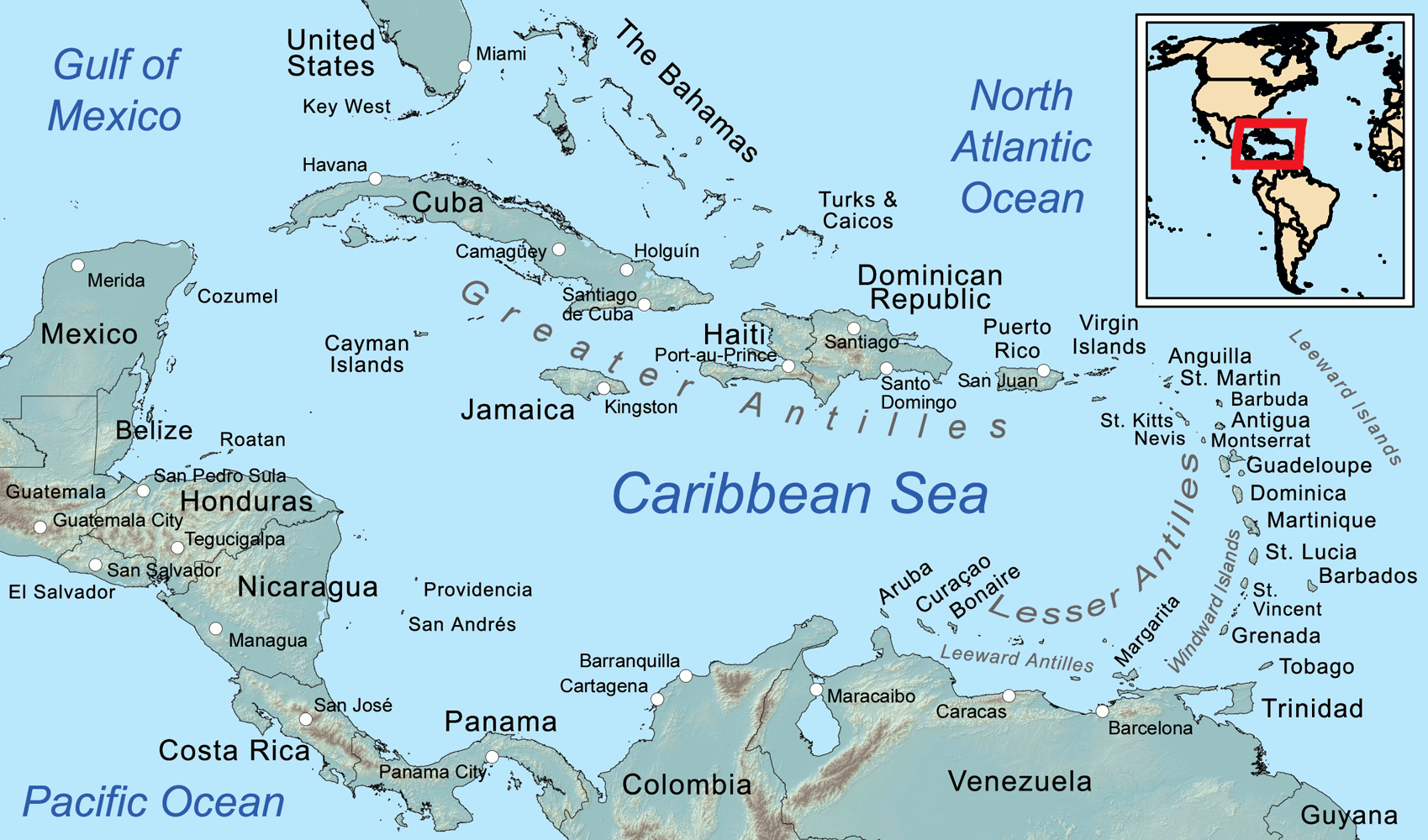
Map
of the Caribbean Sea, showing the Greater, Lesser, and Leeward Antilles, the
Leeward and Windward Islands.
Hispaniola is an island in the Caribbean that is part of the Greater Antilles. iT is the most populous island in the West Indies, and the region's second largest in area, after the island of Cuba.
The 76,192-square-kilometre (29,418 sq mi) island is divided into two separate nations: the Spanish-speaking Dominican Republic (48,445 km2, 18,705 sq mi) to the east and the French / Haitian Creole-speaking Haiti (27,750 km2, 10,710 sq mi) to the west. The only other divided island in the
Caribbean
Sea is Saint Martin, which is shared between France (Saint Martin) and the Netherlands (Sint Maarten).
Hispaniola is the second-largest island in the Caribbean after Cuba.
The island of Cuba lies 80 kilometers (50 mi) to the northwest across the Windward Passage; 190 km (118 mi) to the southwest lies Jamaica, separated by the Jamaica Channel. Puerto Rico lies 130 km (80 mi) east of Hispaniola across the Mona Passage. The
Bahamas and Turks and Caicos Islands lie to the north. Its westernmost point is known as Cap Carcasse.
Cuba, Hispaniola,
Jamaica, and Puerto Rico are collectively known as the Greater Antilles.
Robert
Louis Stevenson named the schooner in his novel: Treasure
Island, The
Hispaniola.
ECONOMY
The island has the largest economy in the Greater Antilles, however most of the economic development is found in the Dominican Republic, the Dominican economy being nearly 800% larger than the Haitian economy. As of 2018, the estimated annual per capita income is US$868 in Haiti and US$8,050 in Dominican Republic.
The economy of the Dominican Republic is the seventh largest in Latin America, and is the largest in the Caribbean and Central American region. The Dominican Republic is an upper-middle income developing country with important sectors including mining, tourism, manufacturing (medical devices, electrical equipment, pharmaceuticals, and chemicals), energy, real estate, infrastructure, telecommunications and agriculture. The Dominican Republic is on track to achieve its goal of becoming a high-income country by 2030, and is expected to grow 79% in this decade. The country is the site of the single largest gold mine in Latin America, the Pueblo Viejo mine.
Although the service sector is currently the leading employer of Dominicans (due principally to growth in tourism and free-trade zones), agriculture remains an important sector in terms of the domestic market and is in second place (behind mining) in terms of export earnings. Tourism accounts for more than $7.4 billion in annual earnings in 2019. Free-trade zone earnings and tourism are the fastest-growing export sectors. A leading growth engine in the Free-trade zone sector is the production of medical equipment for export having a value-added per employee of $20,000 USD, total revenue of $1.5 billion USD, and a growth rate of 7.7% in 2019. The medical instrument export sector represents one of the highest-value added sectors of the country's economy, a true growth engine for the country's emerging market.
Remittances are an important sector of the economy, contributing $8.2 billion in 2020. Most of these funds are used to cover household expenses, such as housing, food, clothing, health care and education. Secondarily, remittances have financed businesses and productive activities. Thirdly, this combined effect has induced investment by the private sector and helps fund the public sector through its value-added tax. The combined import market including the free-trade-zones amounts to a market of $20 billion a year in 2019. The combined export sector had revenues totaling $11 billion in 2019. The consumer market is equivalent to $61 billion in 2019. An important indicator is the average commercial loan interest rate, which directs short-term investment and stimulates long-term investment in the economy. It is currently 8.30%, as of June 2021.
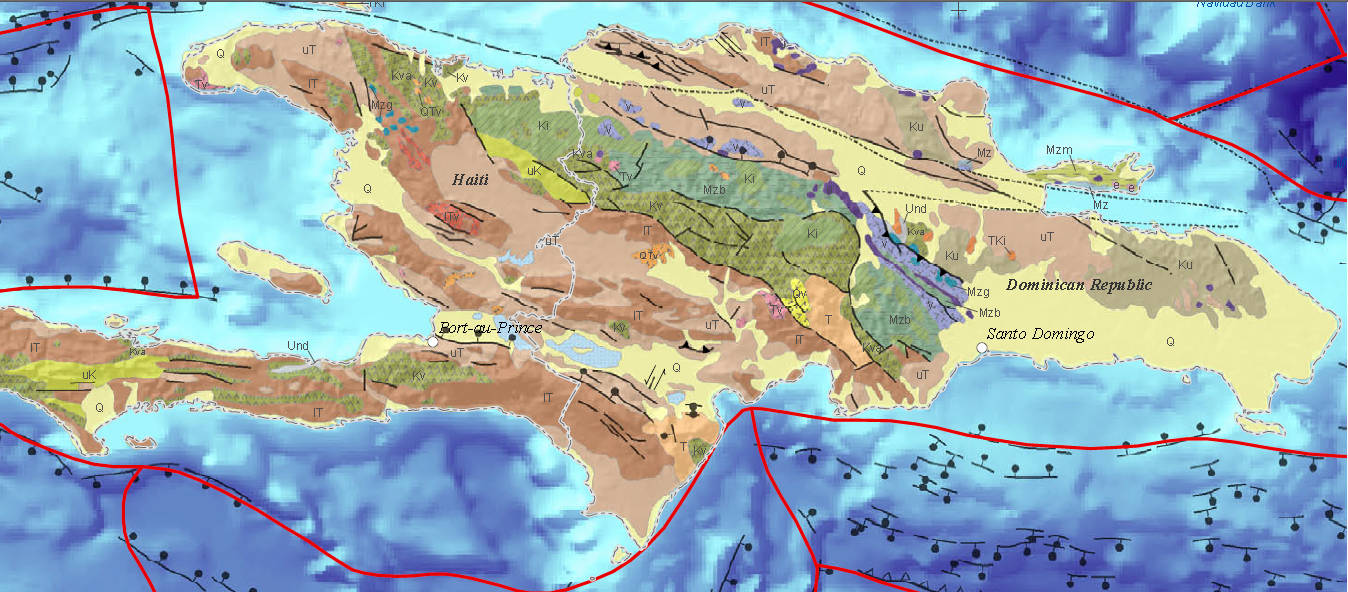
Hispaniola is a Caribbean island that was explored and claimed by Columbus on his first voyage in 1492 and became a springboard for Spanish conquest of the Caribbean and the American mainland.
The Spanish Empire initially claimed the whole island. But due to the inability of Spain to actually enforce that claim, the Western third soon became a haven of piracy and later part of the French Empire, becoming one of the most lucrative and most brutal slavery-based cash-crop colonies as "Saint
Domingue". The eastern two thirds remained Spanish and relatively unimportant.
The Haitian Revolution began in 1791 and ended with France recognizing the new state of Haiti in 1804. Haiti was the former French part; they laid claim to the Spanish parts of the island and briefly conquered them but lost and ultimately gave up all claims to it during the 19th century.
Today the island encompasses two separate countries: Dominican Republic – Occupies the eastern two-thirds of the
island and Haiti – Occupies the western third of the island.
The economy of Haiti is a free market economy with low labor costs. Haiti's estimated population in 2018 was 11,439,646. The British newspaper
The Economist wrote in 2010: Long known as the poorest country in the Western hemisphere, Haiti has stumbled from one crisis to another since the Duvalier years.
In 2005 Haiti's total external debt reached an estimated US$1.3 billion, which corresponds to debt per capita of US$169, in contrast to the debt per capita of the
United States which is US$40,000. Following the democratic election of Aristide in December 1990, many international creditors responded by cancelling significant amounts of Haiti's debt, bringing the total down to US$777 million in 1991. However, new borrowing during the 1990s swelled the debt to more than US$1 billion.
At peak, Haiti's total external debt was estimated at 1.8 billion dollars, including half a billion dollars to the Inter-American Development Bank, Haiti's largest creditor. In September 2009, Haiti met the conditions set out by the
IMF and
World
Bank's Heavily Indebted Poor Countries program, qualifying it for cancellation of some of its external debt. This amounted to a cancellation of $1.2 billion. Despite this as of 2010 calls for cancellation of its remaining $1 billion debts came strongly from civil society groups such as the Jubilee Debt Campaign in reaction to the effects of the earthquake that hit the country.
Haiti uses very little energy, the equivalent of approximately 250 kilograms of oil per head per year. In 2003, Haiti produced 546 million kilowatt-hours of
electricity while consuming 508 million kilowatt-hours. In 2013, it stood 135th out of 135 countries in net total consumption of
electricity.
Most of the country's energy comes from the burning of wood. Haiti imports oil, consuming about 11,800 barrels per day (1,880 m3/d), as of 2003. The Péligre Dam, the country's largest, provides the capital city of Port-au-Prince with energy.

HISTORY
Hispaniola is the site of one of the first European settlements in the Americas, La Navidad (1492–1493), as well as the first proper town, La Isabela (1493–1500), and the first permanent settlement – the current capital of the Dominican Republic, Santo Domingo (est. 1498). These settlements were founded successively in each of Christopher Columbus's first three voyages.
Christopher Columbus first landed at Hispaniola on December 6, 1492 at a small bay he named San Nicolas, now called Môle-Saint-Nicolas on the north coast of present-day Haiti. He was welcomed in a friendly fashion by the indigenous people known as the Taíno. Trading with the natives yielded more gold than they had come across previously on the other Caribbean islands and Columbus was led to believe that much more
gold would be found inland. Before he could explore further, his flagship, the
Santa Maria, ran aground and sank in the bay on December 24. With only two smaller ships remaining for the voyage home, Columbus built a fortified encampment, La Navidad, on the shore and left behind 21 crewman to await his return the following year.
Colonization began in earnest the following year when Columbus brought 1,300 men to Hispaniola in November 1493 with the intention of establishing a permanent settlement. They found the encampment at Navidad had been destroyed and all the crewmen left behind killed by the natives. Columbus decided to sail east in search of a better site to found a new settlement. In January 1494 they established La Isabela in present-day Dominican Republic.
Sugar cane was introduced to Hispaniola by settlers from the Canary
Islands, and the first sugar mill in the New World was established in 1516, on Hispaniola. The need for a labor force to meet the growing demands of sugar cane cultivation led to an exponential increase in the importation of slaves over the following two decades. The sugar mill owners soon formed a new colonial elite.
The first major slave revolt in the Americas occurred in Santo Domingo during 1522, when enslaved Muslims of the Wolof nation led an uprising in the sugar plantation of admiral Don Diego Colon, son of
Christopher
Columbus. Many of these insurgents managed to escape where they formed independent maroon communities in the south of the island.
Beginning in the 1520s, the Caribbean Sea was raided by increasingly numerous French pirates. In 1541, Spain authorized the construction of Santo Domingo's fortified wall, and in 1560 decided to restrict sea travel to enormous, well-armed convoys. In another move, which would destroy Hispaniola's sugar industry, in 1561 Havana, more strategically located in relation to the Gulf Stream, was selected as the designated stopping point for the merchant flotas, which had a royal monopoly on commerce with the Americas. In 1564, the island's main inland cities Santiago de los Caballeros and Concepción de la Vega were destroyed by an earthquake. In the 1560s, English privateers joined the French in regularly raiding Spanish shipping in the Americas.
By the early 17th century, Hispaniola and its nearby islands (notably Tortuga) became regular stopping points for
Caribbean pirates. In 1606, the government of Philip III ordered all inhabitants of Hispaniola to move close to Santo Domingo, to fight against piracy. Rather than secure the island, his action meant that French, English, and Dutch pirates established their own bases on the less populated north and west coasts of the island.
In 1625, French and English pirates arrived on the island of Tortuga. Tortuga located in the northwest coast of Hispaniola, which was originally settled by a few Spanish colonists. The pirates were attacked in 1629 by Spanish forces commanded by Don Fadrique de Toledo, who fortified the island, and expelled the French and English. As most of the Spanish army left for main island of Hispaniola to root out French colonists there, the French returned to Tortuga in 1630 and had constant battles for several decades. In 1654, the Spanish re-captured Tortuga for the last time.
In 1655 the island of Tortuga was reoccupied by the English and French. In 1660 the English appointed a Frenchman as Governor who proclaimed the King of France, set up French colours, and defeated several English attempts to reclaim the island. In 1665, French colonization of the island was officially recognized by King Louis XIV. The French colony was given the name Saint-Domingue. By 1670 a Welsh privateer named Henry Morgan invited the pirates on the island of Tortuga to set sail under him. They were hired by the French as a striking force that allowed France to have a much stronger hold on the Caribbean region. Consequently, the pirates never really controlled the island and kept Tortuga as a neutral hideout. The capital of the French Colony of Saint-Domingue was moved from Tortuga to Port-de-Paix on the mainland of Hispaniola in 1676.
In 1791, during the French Revolution, a major slave revolt broke out on Saint-Domingue. When the French Republic abolished slavery in the colonies on February 4, 1794, it was a European first. The ex-slave army joined forces with
France in its war against its European neighbors. In the second 1795 Treaty of Basel (July 22), Spain ceded the eastern two-thirds of the island of Hispaniola, later to become the Dominican Republic. French settlers had begun to colonize some areas in the Spanish side of the territory.
Under Napoleon, France reimposed slavery in most of its Caribbean islands in 1802 and sent an army to bring Saint-Domingue under tighter control. However, thousands of the French troops succumbed to yellow fever during the summer months, and more than half of the French army died because of disease. After the French removed the surviving 7,000 troops in late 1803, the leaders of the revolution declared western Hispaniola the new nation of independent Haiti in early 1804. France continued to rule Spanish Santo Domingo. In 1805, Haitian troops of General Henri Christophe tried to conquer all of Hispaniola. They invaded Santo Domingo and sacked the towns of Santiago de los Caballeros and Moca, killing most of their residents, but news of a French fleet sailing towards Haiti forced General Christophe to withdraw from the east, leaving it in French hands.
In 1808, following Napoleon's invasion of Spain, the criollos of Santo Domingo revolted against French rule and, with the aid of the United Kingdom, returned Santo Domingo to Spanish control. Fearing the influence of a society of slaves that had successfully revolted against their owners, the United States and European powers refused to recognize Haiti, the second republic in the Western Hemisphere. France demanded a high payment for compensation to slaveholders who lost their property, and Haiti was saddled with unmanageable debt for decades. It became one of the poorest countries in the Americas, while the Dominican Republic gradually has developed into one of the largest economies of Central America and the Caribbean.
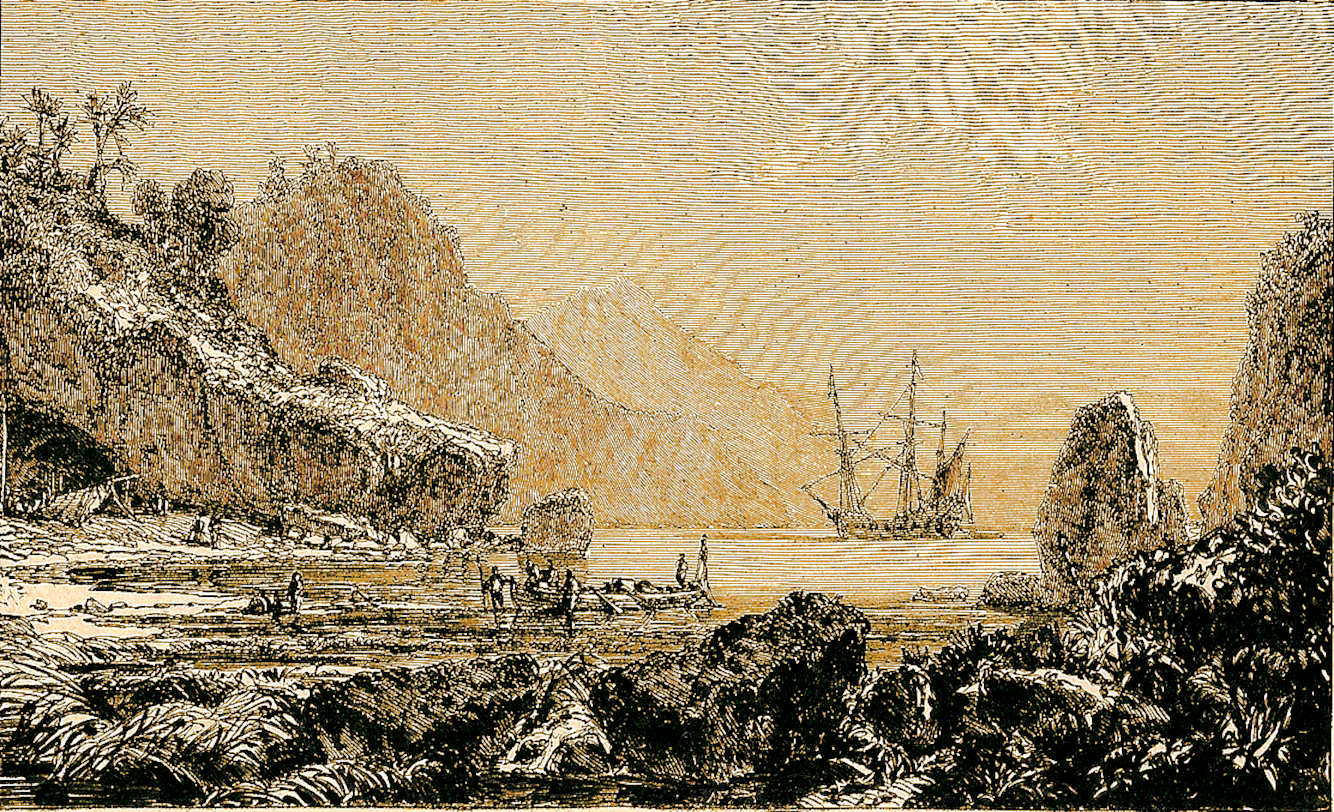
THE
CARIBBEAN ISLANDS BY
POPULATION
1
Cuba 11,252,999
2 Haiti
11,263,077 (Hispaniola)
3 Dominican Republic 10,766,998 (Hispaniola)
4 Puerto Rico (US) 3,508,000
5 Jamaica 2,729,000
6 Trinidad and Tobago 1,357,000
7 Guadeloupe (France) 405,000
8 Martinique (France) 383,000
9 Bahamas 379,000
10 Barbados 283,000
11 Saint Lucia 172,000
12 Curaçao (Netherlands) 157,000
13 Aruba (Netherlands) 110,000
14 Saint Vincent and the Grenadines 110,000
15 United States Virgin Islands
105,000
16 Grenada 104,000
17 Antigua and Barbuda 89,000
18 Dominica 71,000
19 Cayman Islands (UK) 59,000
20 Saint Kitts and Nevis 46,000
21 Sint Maarten (Netherlands) 39,000
22 Turks and Caicos Islands (UK) 37,000
23 Saint Martin (France) 36,000
24 British Virgin Islands (UK) 31,000
25 Caribbean Netherlands
26,000
26 Anguilla (UK) 14,000
27 Saint Barthélemy (France) 10,000
28 Montserrat (UK) 5,000
29
Tortuga 25,936
30
Roatán 110,000
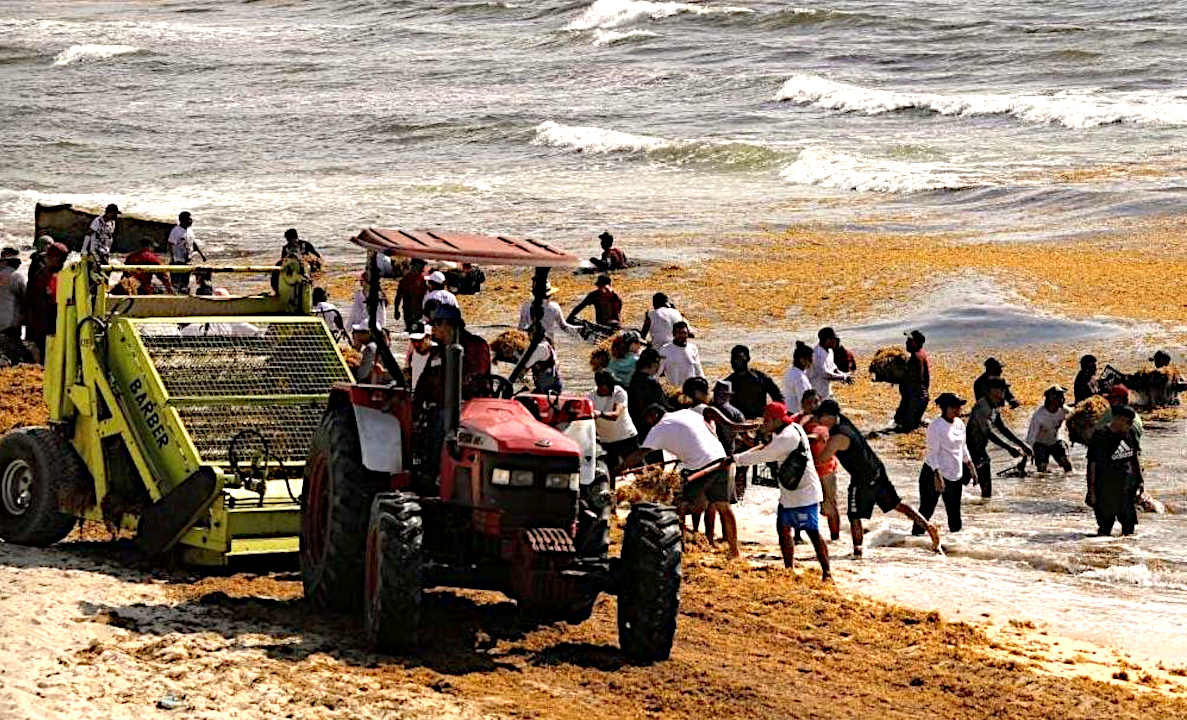
SARGASSUM:
Represents an immediate
threat to the economics of the Caribbean Islands, the
Gulf of
Mexico, and African West Coast, but is
also a potential asset if it can be economically harvested and used for,
among other things, fertilizer for agriculture: where
there is a world shortage.
BIOMASS - BUILDING
MATERIALS - CANCER
TREATMENTS - CLOTHING
& SHOES - CO2
SEQUESTRATION - COSMETICS
FERTILIZERS - FOODS - MEDICINES - MINERALS - PACKAGING - SUPPLEMENTS - VITAMINS

Map
of Port Royal
from 1692, where the notorious buccaneer, Sir Henry Morgan
was buried, along with a Code to give meaning a treasure Map inherited by Lord
Huntington - giving the whereabouts of a Kings ransom. Unfortunately,
Port Royal was sunk when hit by an earthquake and tsunami in June 1692,
along with the grave of the infamous buccaneer, lost in time until
re-discovered by John
Storm and the Elizabeth
Swann. This is the start of a race to find the hidden stash, involving treachery
and industrial espionage.
The
Caribbean
Sea is littered with shipwrecks and dotted with dozens of paradise
islands, where pirates
are said to have buried their treasure.
Many island nations are at risk as to rising
sea levels, caused by climate
change, with the United
Nations powerless to deal with global
warming, being dependent on fossil
fuels. The area has some of the most interesting World
Atlas locations on Planet
Earth.
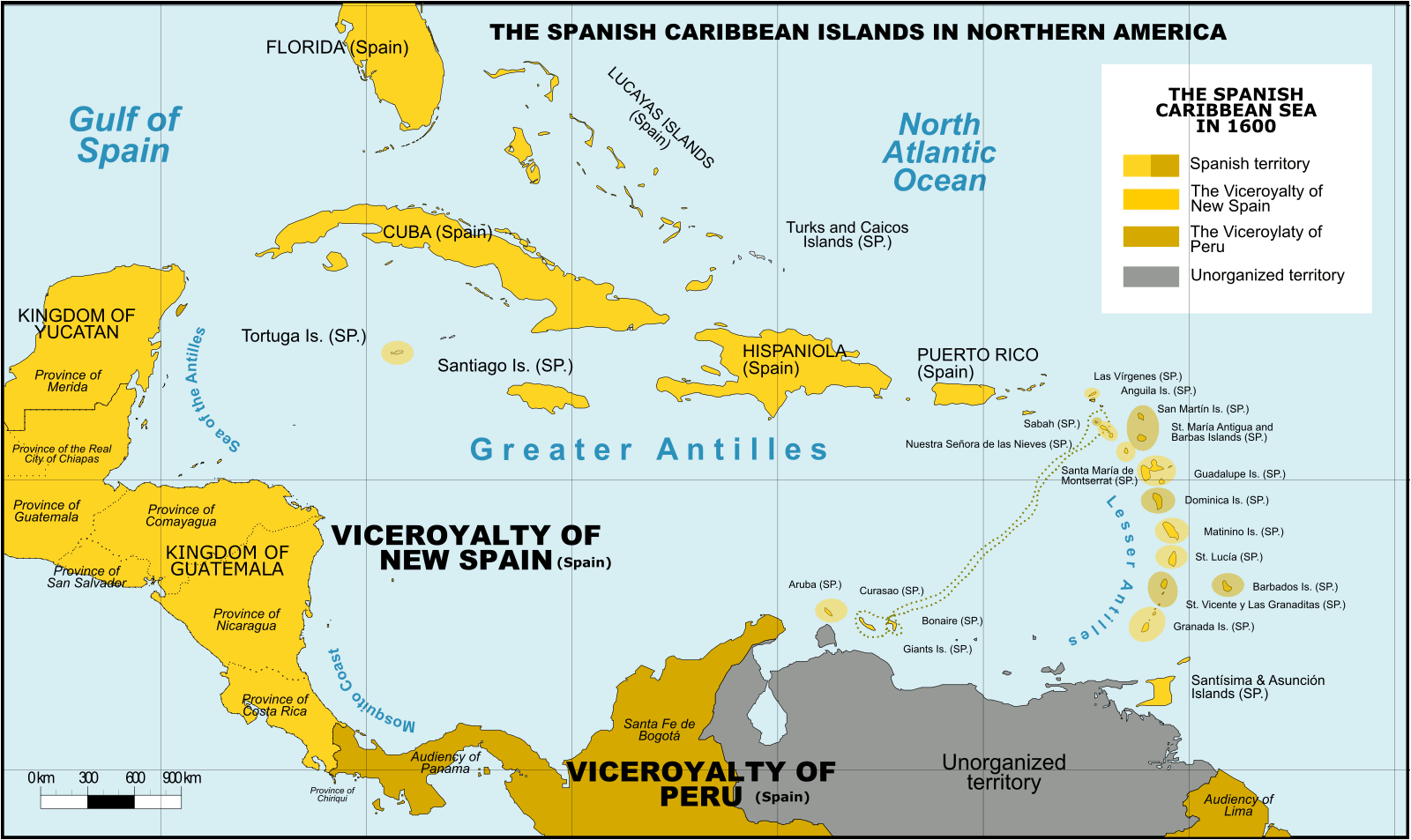
Spanish Caribbean Islands 1600 Spanish Overseas territories Northern America Turks and Caicos Islands (1492-1516, 1516-1678) * Islas Turcas y Caicos The Bahamas (1492-1516, 1516-1648) *Islas Lucayas Bermuda (1503-1516, 1516-1609) *Carabela/Isla de los Diablos Greater Antilles Cuba (1492-1762, 1763-1898) *Juana Cayman Islands (UK) (1503-1670) *Islas de las Tortugas La Española/Hispanola (1492-1795, 1801-1822) Dominican Republic (1492-1795, 1801-1822, 1861-1863) *Santo Domingo Haiti (1492-1793) *Santa María Jamaica (1492-1655) *Isla Santiago Puerto Rico (US) (1493-1898) *San Juan Bautista Lesser Antilles Leeward Islands: Virgin Islands (1493-1587) *Islas Once Mil Vírgenes / Islas Vírgenes St. Thomas (US) (1493-1587) St. John (US) (1493-1587) St. Croix (US) (1493-1587) Water Island (US) (1493-1587) British Virgin Islands (UK) (1493-1648) *Islas Once Mil Vírgenes / Islas Vírgenes Tortola (UK) (1493-1648) Virgin Gorda (UK) (1493-1672) Anegada (UK) (1493-1672) Jost Van Dyke (UK) (1493-1672) Anguilla (UK) (1500-1631, 1631-1650) *Isla de la Anguila Saint Martin/Sint Maarten (France/Neth.) (1493-1631) *San Martín Saint-Barthélemy (Fr.) (1493-1648) *San Bartolomeo Saba (Neth.) (1493-1640) *Saba/San Cristóbal Sint Eustatius (Neth.) (1493-1640) *San Eustaquio St. Kitts and Nevis (1493-1628) *Nuestra Señora de las Nieves Saint Kitts (1493-1628) *San Cristóbal Nevis (1493-1628) *Nieves Antigua and Barbuda Barbuda (1493-1628) *Santa Dulcina Antigua (1493-1632) *Santa María de la Antigua Redonda (1493-1632) *Santa María la Redonda Montserrat (UK) (1493-1632) *Santa María de Monstserrat Guadeloupe (Fr.) (1493-1631) *Santa Guadalupe Windward Islands: Dominica (1493-1635) *Domingo Martinique (Fr.) (1502-1635) *Martinino Saint Lucia (St. Lucia) (1502-1660) *Santa Lucía Barbados (1492-1620) *Los Barbados/El Barbudo St. Vincent and the Grenadines (1498-1627) *San Vicente Saint Vincent the Grenadines Grenada (1498-1650) *Concepción Carriacou & Petite Martinique (Grenada) Trinidad & Tobago (1498-1628) *Santísima e Asunción Aruba (Neth.) (1499-1648) *Aruba/Oroba Curaçao (Neth.) (1499-1634) *Curasao/Isla de los Gigantes Bonaire (Neth.) (1499-1635) * Bonaire/Buon Aire Viceroyalty of New Granada Los Roques Archipelago (Ven) La Orchila (Ven) La Tortuga (Ven) La Blanquilla (Ven) Margarita Island (Ven) Coche (Ven) Cubagua (Ven) Other islands (Ven) *Founded Spanish names
CITIES
LOST IN INNERSPACE
ATLANTIS
- MEDITERRANEAN SEA
ATLIT-YAM
- ISRAEL
BAIA
- ITALY
DWARKA
- INDIA
PAVLOPETRI
- GREECE
PHANAGORIA
- BLACK SEA
PORT
ROYAL - JAMAICA
RUNGHOLT
- DENMARK
THONIS-HERACLEION
AND ALEXANDRIA - EGYPT
YONAGUNI
JIMA - JAPAN
ISLAND
NATIONS UNDER THREAT OF SINKING
Cabo
Verde, Republic of
Carteret
Islands
Fiji,
Republic of
Hawaii
Japan
Kiribati
Maldives
Marshall
Islands, Republic of the
Micronesia,
Federated
States of
Palau
Sarichef
Island
Seychelles
Solomon
Islands
Tangier
Island
Torres
Strait Islands
Tuvalu
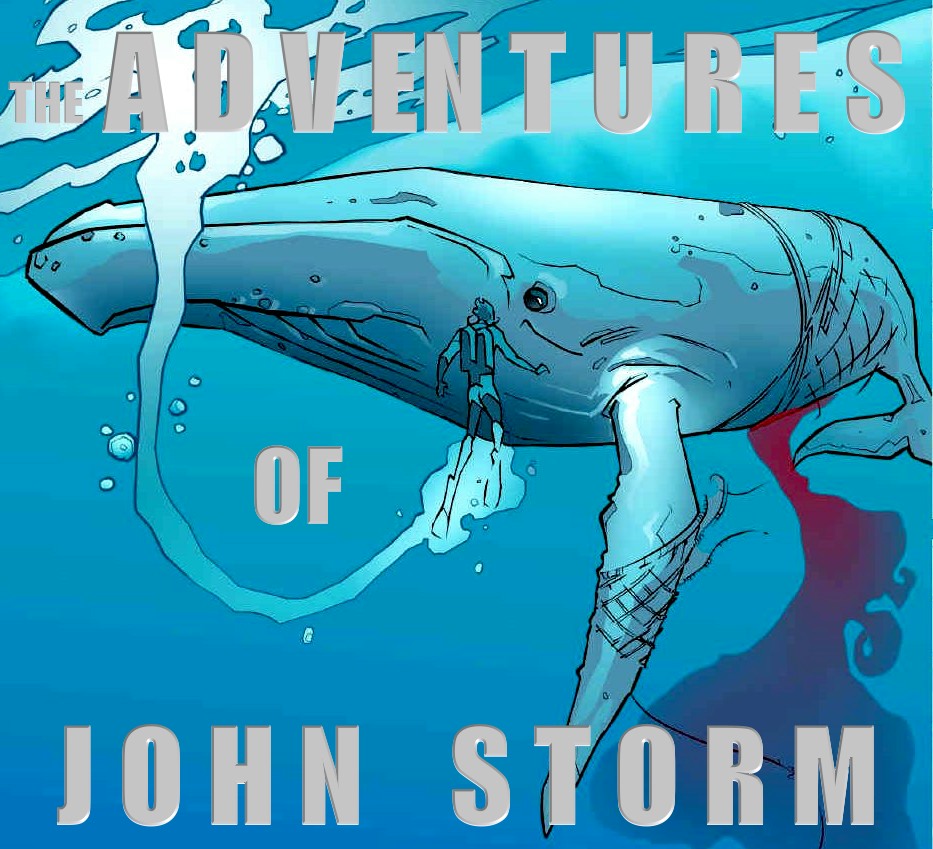
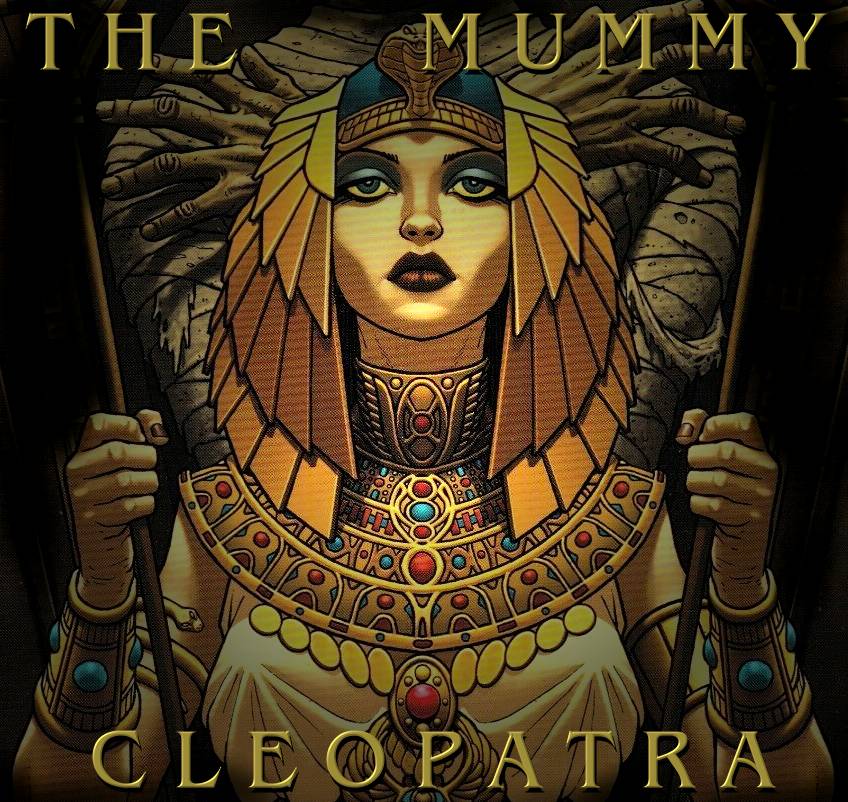
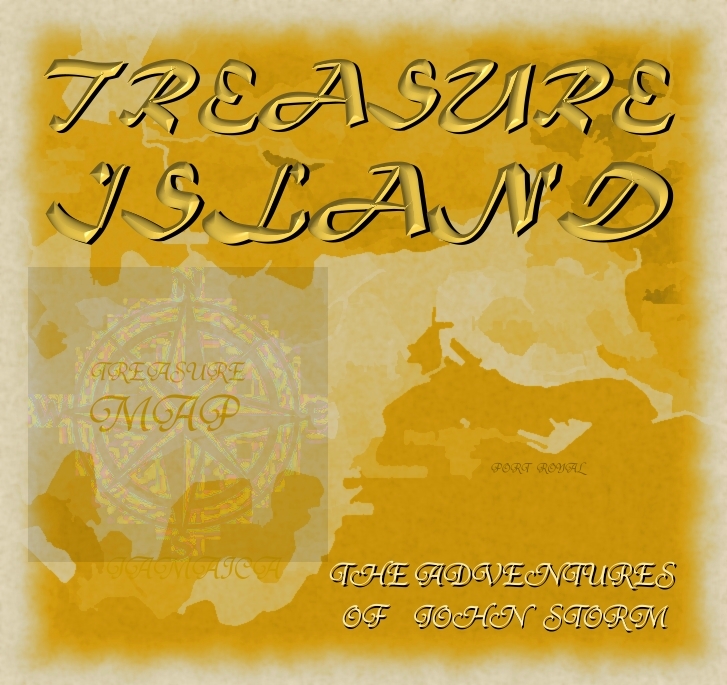
STUDIO/AGENTS: A draft script for
Kulo-Luna is available on request. Cleopatra The Mummy is currently under
development
|






